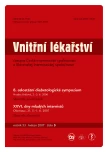-
Medical journals
- Career
Physical activity centre VŠTJ MEDICINA Prague – rehabilitation for diabetics
Authors: P. Fábin 1,3; M. Matoulek 2,3
Authors‘ workplace: Ústav tělovýchovného lékařství 1. lékařské fakulty UK a VFN Praha, přednosta doc. MUDr. Zdeněk Vilikus, CSc. 1; III. interní klinika 1. lékařské fakulty UK a VFN Praha, přednosta prof. MUDr. Štěpán Svačina, DrSc., MBA 2; VŠTJ MEDICINA Praha 3
Published in: Vnitř Lék 2007; 53(5): 563-565
Category:
Overview
Physical activity is the basic non-pharmacological instrument in the treatment of type 2 diabetes. Nevertheless, only a small number of diabetics take regular physical exercise. One of the reasons why diabetics ”do not exercise” is that they have little opportunity to try physical stress under expert supervision and to get to know its effects on, for example, sugar levels. It is a very complex matter to define the optimal intensity of physical activity of, for example, a diabetic who suffers from obesity. In 2001 VŠTJ MEDICINA Prague opened its first physical activity centre at the First Faculty of Medicine, Charles University in Prague, in cooperation with the Third Internal Clinic and the Institute of Sports Medicine of the First Faculty of Medicine, Charles University in Prague. It now has over 2 000 members, of whom around 60 % are patients with metabolic syndrome. Over 150 patients exercise every day under the supervision of expert instructors. The main objective of the Physical Activity Centre is to teach patients the correct principles of physical exercise to enable them to continue carrying out their trainers' instructions at home. A correct understanding of the importance of physical exercise and practical experience under the supervision of experienced instructors improves compliance and has a strong effect on the compensation of diabetes, thereby improving the prognoses of these patients.
Key words:
physical activity – type 2 diabetes mellitus – physical activity centre – compliance
Labels
Diabetology Endocrinology Internal medicine
Article was published inInternal Medicine

2007 Issue 5-
All articles in this issue
- Outline of the physiology and pathophysiology of the senses
- Olfaction and gustation in diabetes
- Diabetes mellitus and cognitive impairments
- Examination of tactile disorders in diabetic patients and cooperation with a neurologist
- Diabetic ophthalmopathy
- Pathogenesis of diabetic retinopathy
- Cataracts, glaucoma and diabetes mellitus
- Surgical treatment of diabetic retinopathy
- Pharmacological treatment of diabetic retinopathy
- Inflammatory diseases of the eye
- Thyroid orbitopathy and diabetes
- Sensorineural hearing loss in diabetes. Prosthetic care in hearing impaired patients
- Tinnitus and diabetes
- Development of opinions on physical exercise for diabetics
- Exercise therapy for patients with metabolic syndrome
- Metabolic importance of muscles and the role of sports in diabetic patients
- Nutrition for diabetics in relation to physical exertion
- Therapeutic regimes accompanying physical exercise for diabetics
- Increased activity of the sympathetic nervous system and the possibilities for therapeutic influence
- Defining the level of physical activity for a diabetic who is obese
- Physical activity centre VŠTJ MEDICINA Prague – rehabilitation for diabetics
- Rehabilitation and prosthetic care for diabetic patients after the extremity amputation
- Editorial
- Internal Medicine
- Journal archive
- Current issue
- Online only
- About the journal
Most read in this issue- Inflammatory diseases of the eye
- Tinnitus and diabetes
- Increased activity of the sympathetic nervous system and the possibilities for therapeutic influence
- Olfaction and gustation in diabetes
Login#ADS_BOTTOM_SCRIPTS#Forgotten passwordEnter the email address that you registered with. We will send you instructions on how to set a new password.
- Career

